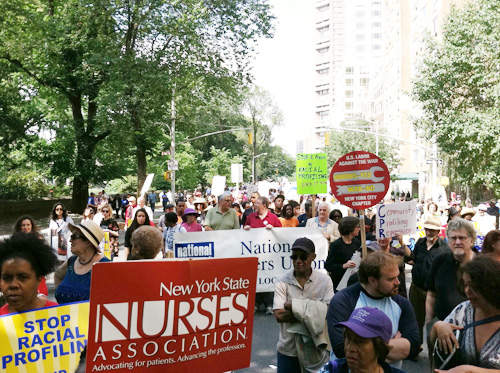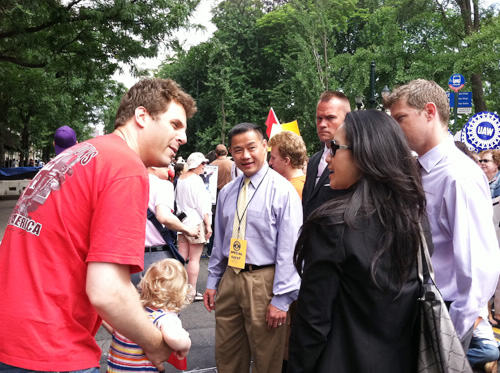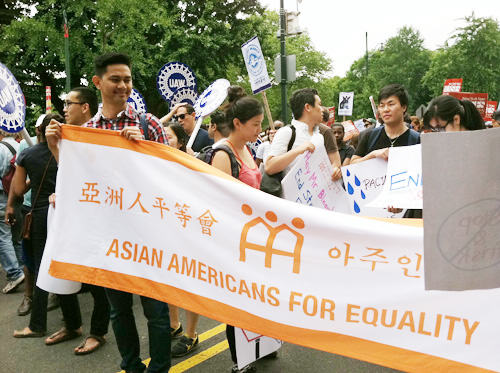|
 |
|
SHOWING SUPPORT: Some 300 organizations, including unions, religious groups, student groups and civil rights groups attend the silent protest against the New York Police Department's "stop-and-frisk" policy in New York City on June 17 (CORRIE DOSH) |
They marched arm-in-arm without saying a single word – thousands of citizens joined in single purpose on June 17 as they flooded down New York City's Fifth Avenue past some of the city's richest real estate. They held signs proclaiming their affiliations to labor groups, gay rights groups, occupiers, Quakers and anarchists; all united in a silent protest against the New York Police Department's "stop-and-frisk" policy that allows officers to interrogate and search New Yorkers without establishing suspicions of criminal activity. Instead of protecting the public, the policy has become a way to discriminate against young, male minorities, say protestors.
The policy targets the black and Latino communities, say organizers. In 2011, New Yorkers were stopped by the police 685,724 times, according to the American Civil Liberties Union (ACLU). Fifty-four percent of those detained were black and 34 percent were Latino, even though they respectively comprise only about 23 percent and 29 percent of New York City's total population. The overwhelming majority of those stopped, 88 percent, were totally innocent, said the ACLU. Though the NYPD claims the policy cuts down on gun violence, only 1.9 percent of stops resulted in the discovery of a weapon. In February, unarmed teenager Ramarley Graham was shot and killed by an NYPD officer as he fled from an attempted stop-and-frisk – heightening tensions and sparking protests against the controversial policy.
Young men at the protest spoke of being harassed regularly by police. Horace Russell, a teacher in the New York borough of the Bronx, told CNN he feels targeted "every single day".
"I've been pulled over and pushed against fences, frisked, but have never been arrested," Russell said.
Wade Cummings, 46, and his 19-year-old son Tarik, told the New York Times that both had been stopped by police officers without cause – once for the father, and three times for the son.
 |
|
DIRECT RESPONSE: New York City Comptroller John Liu (middle) shows up at the silent protest against the New York Police Department's "stop-and-frisk" policy in New York City on June 17 (CORRIE DOSH) |
"It's racial profiling of people who are almost all innocent of any wrongdoing," New York City Comptroller John Liu told reporters as he marched with a group of young Asian protestors. Liu pointed to examples of "strategies of focused deterrents" in Atlanta, Chicago and Boston that he said would "actually reduce crime" while avoiding racial profiling.
While it wasn't the first protest against the NYPD policy, Sunday's march was notable for its deafening silence. Wave after wave of protestors marched without a word, past the throngs of tourists at the Metropolitan Museum of Art (who snapped pictures in bewildered fascination) and the Father's Day picnics in Central Park.
"In this city of so much hustle and bustle and clamor, sometimes the loudest thing you can do is move together in silence," one protestor told the New York Times as he marched with his daughter.
Some 300 organizations had given their support for the march, including unions, religious groups, student groups and civil rights groups. The United Federation of Teachers marched in the middle of the parade, under large blue umbrellas.
"How can we teach justice and equality when they live a life that contradicts that everyday?" Leroy Barr, the director of staff at the labor uniontold The Nation. "It's difficult to have the impact in the classroom that you need to have when they live in a world that is completely different than what we teach."
 |
|
DEFENDING RIGHTS: Asian American students in New York City hold a banner on June 17 during a silent protest against the New York Police Department's "stop-and-frisk" policy that allows officers to interrogate and search New Yorkers without establishing suspicions of criminal activity (CORRIE DOSH) |
The silence broke as the march ended a block from Mayor Michael Bloomberg's residence. Voices began to chant: "We can't be silent. We've got to fight back". Police began to scuffle with a dozen agitators, arresting some and driving others away. The mayor was not at home – he attended services at a predominantly African-American church in Brooklyn and spoke to reporters, promising to "do a better job" to treat the innocent with respect but defending the policy. Since Bloomberg came into office in 2002, the rate of stop-and-frisks in the city has increased by 600 percent. The first quarter of 2012 marked the highest rate of stops to date.
"We believe that when it comes to making stops … the practice should be mended, not ended," Bloomberg said.
(Reporting from New York City) | 